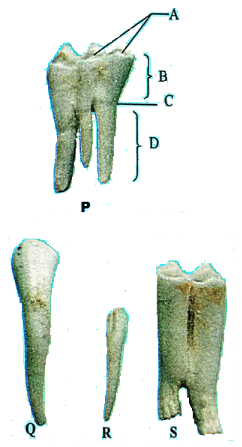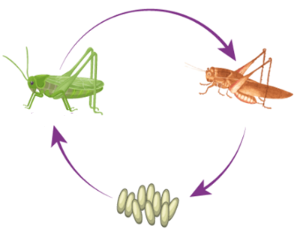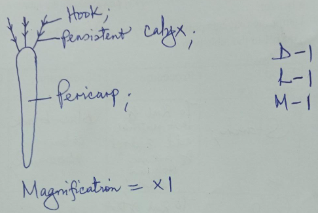INSTRUCTIONS TO CANDIDATES
- Answer ALL the questions
- You are provided with a fruit labelled K. You are required to cut transversely through the middle section of the fruit using the knife provided. You are to use one half of the fruit for question 1 and preserve the other half for question 2.
- Cut a 1cm slice from one half of the fruit and remove the peel. Place the soft part of the fruit in a mortar and mash it into a fine paste using a pestle.
Add 10 ml of distilled water into the paste and stir the mixture, then transfer it into a beaker. - Using the reagents provided, carry out appropriate food tests on the mixture as you fill in the table below: (12 marks)
Food substance Procedure Observations Conclusion - Name the deficiency disease in children that may result from feeding them on specimen K alone especially after weaning. (1mk)
- Identify the hormone responsible for ripening of the specimen K above. (1mk)
- Cut a 1cm slice from one half of the fruit and remove the peel. Place the soft part of the fruit in a mortar and mash it into a fine paste using a pestle.
- Using specimen K and M provided;
- Identify the types of fruits and give reasons (4mks)
Specimen Reason K M - State the mode of dispersal of specimen M and give a reason (2mks)
Mode of dispersal………………………………………………………………………………
Reason……………………………………..... - State and explain how fruit K is formed (2mks)
- Draw and label fruit M (3mks)
- When a piece of specimen K was placed in hydrogen peroxide solution, bubbles were produced. State the physiological process that is similar to it in human that was being investigated (1mk)
- Identify the types of fruits and give reasons (4mks)
-
- You are provided with photographs of specimens labeled P, Q, R and S which were obtained from the same animal. Examine them and answer the questions that follow.

- With a reason identify P and Q. (4mks)
P …………………………………………………………………………………
Reason …………………………………………………………………………..
Q ………………………………………………………………………………...
Reason ………………………………………………………………………….. - Using observable features only state.
- One similarity between specimen Q and R. (1mark)
- One difference between specimen R and S. (1mark)
- Explain how specimen S is adapted for its functions. (1mks)
- In specimen P name the four parts labeled. (2mks)
- A ………………………………………………………………..
- B ………………………………………………………………..
- With a reason identify P and Q. (4mks)
- The diagram below shows a process that takes place in some insects.Study it and answer the questions that follow.
- Identify the life cycle above (1mk)
- Name two hormones that control the process (2mks)
- Explain the importance of the process to organisms where it occurs? (2mks)
- You are provided with photographs of specimens labeled P, Q, R and S which were obtained from the same animal. Examine them and answer the questions that follow.
CONFIDENTIAL
- Ripe banana(specimen K); one per student; each candidate to use 1cm section for question 1 and reserve the other section for question 2
- Black jack fruit (specimen M)
- Pestle and mortar
- 4 test tubes
- 10 ml measuring cylinder
- Iodine solution
- Benedict’s solution
- NaOH solution
- CuSO4 solution
- Two 50ml beakers
- Source of heat (water bath)
- Distilled water in wash bottle
- Hand lens
MARKING SCHEME
- You are provided with a fruit labelled K. You are required to cut transversely through the middle section of the fruit using the knife provided. You are to use one half of the fruit for question 1 and preserve the other half for question 2.
- Cut a 1cm slice from one half of the fruit and remove the peel. Place the soft part of the fruit in a mortar and mash it into a fine paste using a pestle.
Add 10 ml of distilled water into the paste and stir the mixture, then transfer it into a beaker. - Using the reagents provided, carry out appropriate food tests on the mixture as you fill in the table below: (12 marks)
Food substance Procedure Observation Conclusion starch To 2ml test material in test tube;add 3 drops of iodine solution;shake Blue-black colour; Starch present; Reducing sugars To 2ml of test material in test tube;add equal amounts of Benedicts solution;heat in water bath; Green/yellow/orange/brown colour; Reducing sugars present; Proteins To 2ml of test material;add equal amounts of NaOH;add CuSO4 dropwise;shaking after each drop; Blue colour persists; Proteins absent; - Name the deficiency disease in children that may result from feeding them on specimen K alone especially after weaning. (1mk)
…………………Kwashiokor;………………………………………………………………… - Identify the hormone responsible for ripening of the specimen K above. (1mk)
………………………………Ethylene/ethene;………………………………………………
- Cut a 1cm slice from one half of the fruit and remove the peel. Place the soft part of the fruit in a mortar and mash it into a fine paste using a pestle.
- Using specimen K and M provided;
- Identify the types of fruits and give reasons (4mks)
Specimen Reason K Berry; Succulent/fleshy (pericarp); MCypsela; Persistent calyx; - State the mode of dispersal of specimen M and give a reason (2mks)
- Mode of dispersal…Animal;……………………
- Reason………………………presence of hooks;(to stick onto animal’s fur/hair)
- State and explain how fruit K is formed (2mks)
- Formed by parthenocarpy; ovary changes to fruit without fertilization
- Draw and label fruit M (3mks)
- When a piece of specimen K was placed in hydrogen peroxide solution, bubbles were produced. State the physiological process that is similar to it in human that was being investigated (1mk)
- Detoxification
- Identify the types of fruits and give reasons (4mks)
-
- You are provided with photographs of specimens labeled P, Q, R and S which were obtained from the same animal. Examine them and answer the questions that follow.
- With a reason identify P and Q. (4mks)
- P ……molar;……………………………………………………………………………
Reason …presence of three roots ; - Q …incisor;
Reason …chisel shaped/has one root;
- P ……molar;……………………………………………………………………………
- Using observable features only state.
- One similarity between specimen Q and R. (1mark)
- One root;
- One difference between specimen R and S. (1mark)
(Mark first 1 correct)R S One root; Two/three roots; Lacks cusps/ridges; Has cusps/ridges; Smaller/narrower crown; Broader/wider crown; - Explain how specimen S is adapted for its functions. (1mks)
- Has three/two roots for anchorage; (owtte)
- Ridges/cusps;for crushing/grinding;
- Wider surface area;for chewing and grinding; (any 1)
- One similarity between specimen Q and R. (1mark)
- On specimen P name the parts labeled A and B (2mks)
- With a reason identify P and Q. (4mks)
- The diagram below shows a process that takes place in some insects.Study it and answer the questions that follow.
- Identify the life cycle above (1mk)
- Incomplete metamorphosis;……………
- Name two hormones that control the process (2mks)
- Juvenile hormone;
- Ecdysone hormone; (rej moulting hormone)
- moulting stimulating hormone;
- Explain the importance of the phenomenon to organisms where it occurs? (2mks)
- Organisms can occupy different ecological niche;(reducing competition)
- Allows more time for development of structures/ organs ;.
- Identify the life cycle above (1mk)
- You are provided with photographs of specimens labeled P, Q, R and S which were obtained from the same animal. Examine them and answer the questions that follow.
Join our whatsapp group for latest updates
Tap Here to Download for 50/-
Get on WhatsApp for 50/-
Download Biology Paper 3 Questions and Answers - Mokasa 1 Joint Mocks Exams 2023.
Tap Here to Download for 50/-
Get on WhatsApp for 50/-
Why download?
- ✔ To read offline at any time.
- ✔ To Print at your convenience
- ✔ Share Easily with Friends / Students


